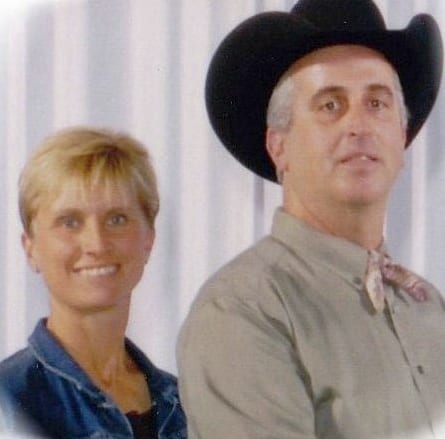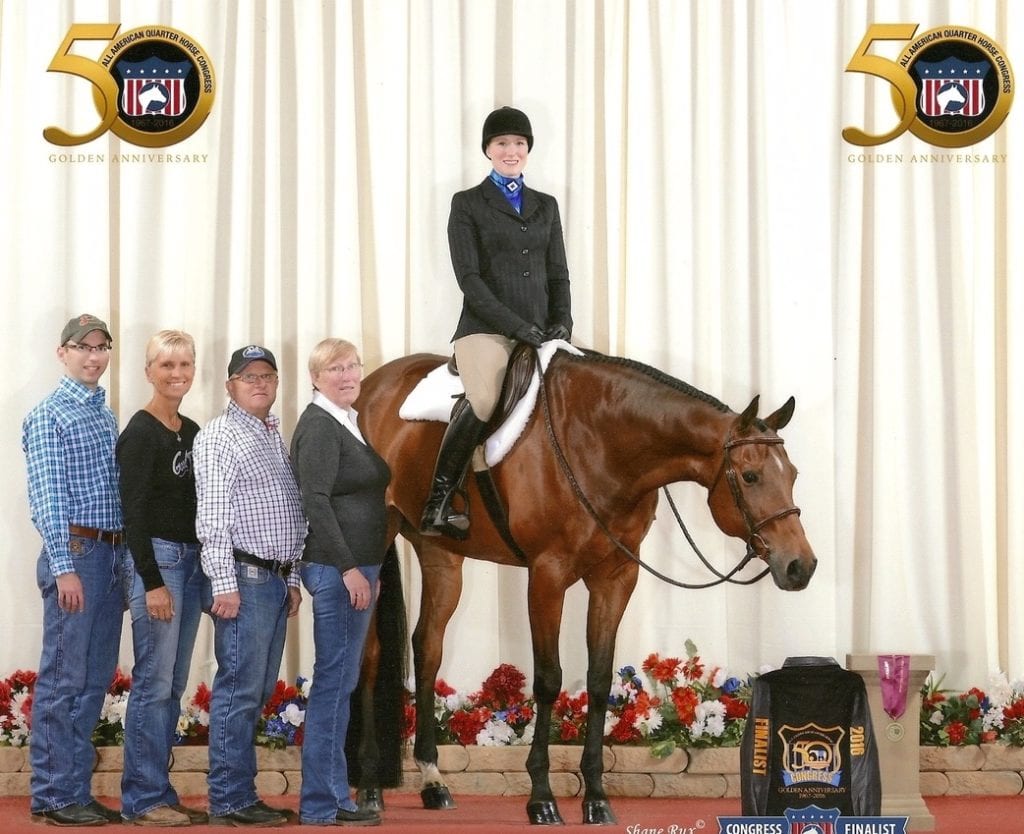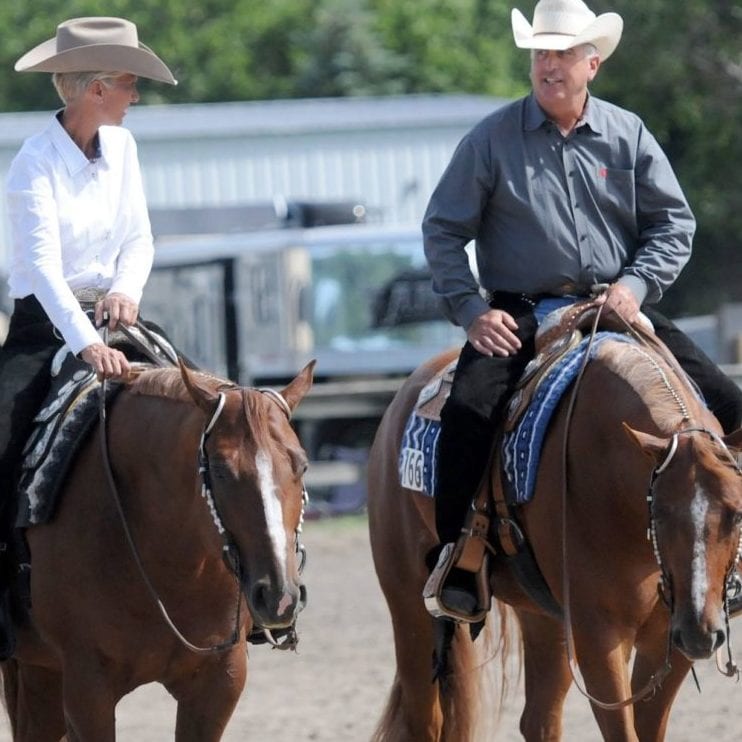Our northern neighbors in Canada may sometimes feel overlooked since most of the major shows on the Quarter Horse and Paint show circuit are in the United States. However, there is a thriving horse community in Canada with several large shows and deep competition.
GoHorseShow wanted to find out more about trainers and shows in Canada, so we asked Tracey and Glen Patterson and Darci Rapley the ins and outs of running a training business in Canada. They discussed the advantages and disadvantages as well as similarities and differences of showing above the border.
Tracey and Glen Patterson of Binbrook, Ontario, Canada
This couple has been training horses for over 25 years. They both showed as youth and amateurs prior to starting out at club shows and then moving on to AQHA and APHA breed shows. When the couple started training, they mainly worked with young horses for the western pleasure and hunter under saddle classes and futurities.
While they first trained mainly Paint horses, now it has changed to mostly Quarters. In their career, they have been fortunate enough to have prepared some great horses including World Champions and Congress winners.
 Their business has now shifted into doing more all-around horses for youth and amateurs. Glen and Tracey still start many young prospects, but now with the hope that they will go on to be all-arounders down the road.
Their business has now shifted into doing more all-around horses for youth and amateurs. Glen and Tracey still start many young prospects, but now with the hope that they will go on to be all-arounders down the road.
“Training horses can certainly have its ups and downs. Probably the best thing about training a young prospect is that you get to watch it progress and do well in the show arena,” Tracey told us. “It is also gratifying to watch a person that we are coaching achieve their goals with their horses. Another bonus is that we get to meet a lot of great people, either as customers or as fellow competitors.”
We asked them what it’s like training horses above the US border. “Training in Canada has been very good to us over the years. When we started out, we had nothing, but thanks to a lot of good customers over the years, we have managed to have a successful business,” Tracey reveals. “The climate in Canada can make things difficult, but it is no different than a majority of the northern United States, especially where we are located. One of the worst parts is that for probably six months of the year, we have to ride in our indoor. Mentally, this is hard on both the horses and us after a while.”
 Tracey states that there is not much of a difference between US and Canada shows except that more exhibitors show without the assistance of a trainer. She also mentions a few challenges.
Tracey states that there is not much of a difference between US and Canada shows except that more exhibitors show without the assistance of a trainer. She also mentions a few challenges.
“The weather can make training and trailering in the winter difficult. The show season in Ontario is quite short. The shows start in mid-May and end on Labor Day weekend,” Patterson says. “This is a big challenge financially unless you have customers who are willing to travel further to shows. Another challenge in Ontario is the availability of good show facilities. Fortunately for us, one of the better facilities is close to us. Another big challenge about being in Canada is getting people to come to look and purchase horses. Many people do not have passports and do not want the extra hassle of the border crossing.”
 Tracey says that crossing the border into the US is not typically tricky, as long as you have all of your border crossing paperwork in order. It is, however, an added expense as you need a Coggins done within six months and export papers. It is also more expensive to show in the US due to the currency exchange cost.
Tracey says that crossing the border into the US is not typically tricky, as long as you have all of your border crossing paperwork in order. It is, however, an added expense as you need a Coggins done within six months and export papers. It is also more expensive to show in the US due to the currency exchange cost.
“Showing and training in Canada has been very good to us over the years. The weather is a challenge, but it makes you appreciate the great weather we do get,” Patterson reflects. “I cannot imagine doing anything else other than being a trainer. We have often talked about moving to a better climate, but, unfortunately, I do not see that happening. We have a lot of great clients here, and Canada has been good to us over the years.”
Darci Rapley of Cayuga, Ontario, Canada
 Darci Show Horses is located in the beautiful rolling hills of Cayuga Ontario. Darci told us that she is very blessed to be able to run her business out of JD Acres, proudly built and owned by Dan and Jennifer Fulsom.
Darci Show Horses is located in the beautiful rolling hills of Cayuga Ontario. Darci told us that she is very blessed to be able to run her business out of JD Acres, proudly built and owned by Dan and Jennifer Fulsom.
“Much of my program focuses on young prospects that are built from the ground up,” Darci says. “It’s exhilarating developing the youngsters from scratch. They are all so different. Some train up easily while others can be a challenge. That’s the part that I love. I do have quite a few clients that breed and raise their prospects. It’s always interesting to see what direction their talent will take them for all of us.”
Rapley told us that in Ontario, it’s easy to find at least two or three shows to attend per month. However, her clients love to travel to the states to attend some futurities and different horse shows.
“We enjoy showing in Canada, but feel it’s also important to challenge ourselves with new competition. The most common comment I receive when showing in the states is, ‘Wow, you are from Canada? That must be far!’ We are not far from the border at all. Many shows in New York and Michigan are four hours or less away.”
 A fun fact about Darci is that she is an American with permanent residency status in Canada.
A fun fact about Darci is that she is an American with permanent residency status in Canada.
Like the Patterson’s mentioned, the most substantial challenge is the weather. “We ride regardless of the temperatures, but sometimes it’s super cold. Another challenge is when we only show in Ontario. We tend to feel a bit out of the loop, so, we try to show stateside as much as we can.”
Darci adds, “I want to thank my clients for giving me the opportunities they do and by sticking with me through life’s ups and downs. The shows up here are very tight-knit. We see many of the same faces every weekend. Coming from Canada to show in the states makes us feel like the underdogs of sorts, and that’s quite cool. I feel that it shouldn’t matter where you are from to be a successful horse trainer. It should show in your dedication and hard work.”








